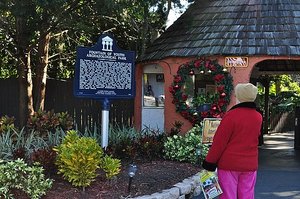Advertisement
Published: June 16th 2017

 Tried to Break In--Needed Powers of Fountain
Tried to Break In--Needed Powers of Fountain
Old guys have to use every possibility to regain that 300 yard drive.Geo: 29.892, -81.3143
You go for the history, but you stay for the eclectic little shops surrounding old town. I could stay a week wandering in and out of tiny, classy, funky eye-candy shops on tiny, narrow, closed-in, cobbled, wobble-d lanes.
St. Augustine was Spain's bastioned battle front against the hungry British and French. This was a veritable lifeline of wealth they were protecting. I mean...Spain had been pouring gold and silver from Peru and Bolivia into Spanish coffers for years through these waters, and had no intention of brooking opposition. They could deal with the pirates, but the British were no longer content to pick off a ship or two. They wanted the trade route. They wanted it all.
The upstarts were to be nailed!
St. Augustine had one of the few usable harbors on this north flowing Gulf Stream along the Florida coast, which landed it smack in the middle of the frey between Spain, France and England. And as such was the first city established by Europeans in the new country. First the Spanish established it in 1565, then the British managed a bloody take-over in 1763 which lasted until 1784 when the Spanish grabbed it back. Finally it became part of

 Equally as Cold as Montana
Equally as Cold as Montana
Record breaking Florida cold with a wind blowing off the ocean --I never felt that cold before!the United States in 1821. The French tried in there somewhere, but failed.
And don't forget Ponce de Leon and the Fountain of Youth that for $9 too you can see. When we rolled into town and saw the gagginess surrounding Ponce de Leon's landing place I was no longer interested in St. Augustine. It totally soured me on the place--but the Castillo (fort) was so well done and the old town so wonderful, I repented and fell in love.
NOTE: When Ponce de Leon landed, he declared ALL of North America for SPAIN, and Bob says, had that worked out, we wouldn't have to go to Uruguay for Spanish classes. We'd be espanol-y-ing up a storm.
So you see, the place is full of history and charm and wonderful wacky funky fun. And we actually saw so little of it. It was so blasted cold with the wind whipping across the bay and temps down to record lows, we saw the fort and retreated to a nice warm gift shop.
You can see why I have to go back.
Advertisement
Tot: 0.059s; Tpl: 0.019s; cc: 9; qc: 23; dbt: 0.0383s; 1; m:domysql w:travelblog (10.17.0.13); sld: 1;
; mem: 1mb

 Tried to Break In--Needed Powers of Fountain
Tried to Break In--Needed Powers of Fountain
 Equally as Cold as Montana
Equally as Cold as Montana








